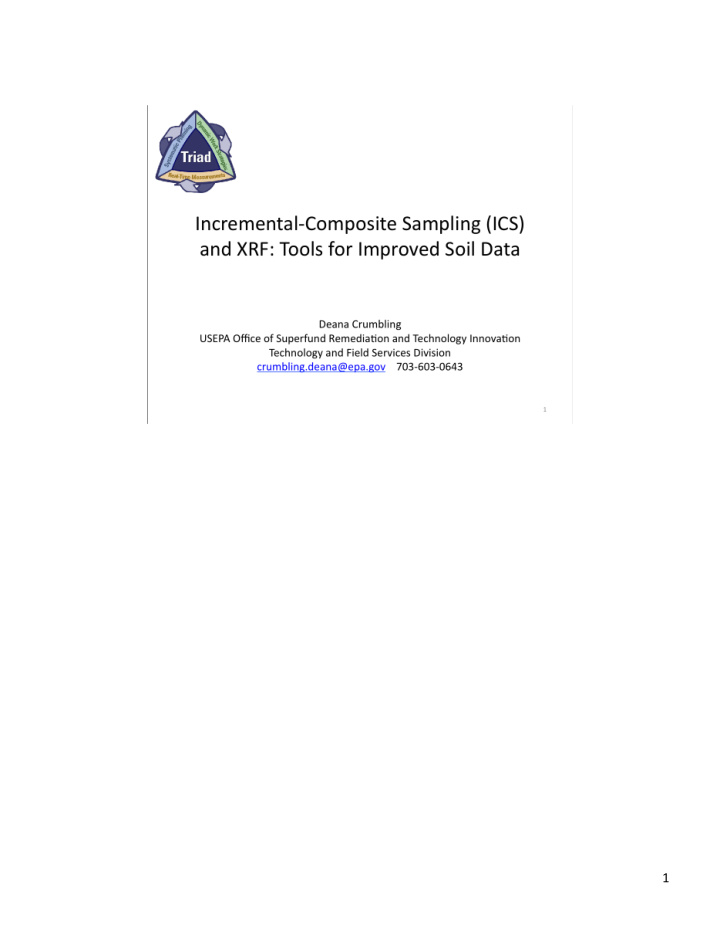



1
Using incremental and/or composite sampling vastly improves the representaKveness of soil or sediment ¡data. Why can I make that ¡claim? 2
Using incremental and/or composite sampling vastly improves the representaKveness of soil or sediment ¡data. Why can I make that ¡claim? 3
Using incremental and/or composite sampling vastly improves the representaKveness of soil or sediment ¡data. Why can I make that ¡claim? 4
The same principles apply to short-‑scale sampling error. Recall that ¡this refers to extrapolaKng single data ¡point ¡to a large field area ¡without ¡taking heterogeneity into account. Taking the whole targeted soil volume as a single sample for analysis would provide THE concentraKon for that ¡volume without ¡ any sampling error. Of course, that’s not ¡possible. That’s why we take samples. The trick is to have enough samples to capture field heterogeneity without ¡breaking the bank. This can be done by taking increments of soil from many locaKons and pooling them together for a single analysis. This both increases sampling density of the area ¡AND increases the sample support ¡of the field sample—both of which help control sampling error. When increments are pooled for this purpose, it’s called incremental sampling. 5
Joanna ¡Becker, Perdue Univ. PhD thesis, 2005, CenKmeter scale analysis of soil heterogeneiKes within a long-‑term, heavy metal contaminated site. Becker, Joanna ¡M., T. Parkin, C.H. Nakatsu, J.D. Wilbur and A. Konopka ¡(2006) Bacterial AcKvity, Community Structure, and CenKmeter-‑Scale SpaKal Heterogeneity in Contaminated Soil. Microbial Ecology Vol. 51, 220-‑231. Mass of soil in 4-‑inch circle (to ½-‑inch depth) = 160 g (assuming soil density of 1.5 g/ cubic ¡cm) 6
7
If the enKre DU could be analyzed in a single giant ¡analysis, there would be no uncertainty about ¡the true Pb concentraKon. Note that ¡this process would produce a result ¡that ¡represents a giant ¡composite of all soil parKcles in the DU. 8
Assume no analyKcal error. 9
For this thought ¡experiment, again assume that ¡there is no analyKcal error. Since a single DU cannot ¡be analyzed in a single analysis, we must ¡take samples, analyze them, and then draw conclusions about ¡the DU concentraKon from the concentraKon of the samples. In scenario A, we take more samples (n = 33), but ¡it ¡is expensive to analyze them all. So we perform a physical averaging by combining all the samples (now called increments) together to form a single composite called an incremental sample, which is analyzed. This is equivalent ¡to taking 33 samples and analyzing all individually, then mathemaKcally averaging all 33 results. Because this is not ¡an analysis of the enKre volume, there is uncertainty about ¡how close the sample average is to the true concentraKon. With only 1 analysis, it ¡is not ¡possible to determine how much uncertainty is present ¡in the result. However, if we take mulKple independent ¡ incremental samples, we can determine uncertainty. In scenario B, we take 4 discrete (grab) samples. Because we want ¡to use those samples to determine the actual concentraKon for the enKre DU, we take the average of the 4 data ¡points. Since we are using 4 small samples taken from a heterogeneous medium (soil), there is uncertainty in whether the average of the 4 data ¡points accurately represents the concentraKon for the DU. We can calculate an esKmate of the uncertainty from the variability between the 4 results. In scenario C, we take 1 discrete sample. There is sampling uncertainty present, but ¡ we have no way to esKmate how large that ¡uncertainty is. Which design looks like it ¡would be more representaKve of the true concentraKon of the DU? 10
11
12
13
Here’s what ¡we mean by “parKcle segregaKon.” • These photos contrast ¡non-‑segregated soil with segregated soil • With shaking or jiggling, larger parKcles migrate to the top while smaller parKcles seMle downward • SKrring to “mix” is ineffectual to redistribute parKcles; o<en makes segregaKon worse • If subsampling involves scooping off the top, could predominately get ¡larger parKcles; but ¡this depends on another factor (see next ¡slide) 14
15
Speaker bullets ¡ •2 D slabcake •Lower cost ¡than sectorial spliMer •PreMy good representaKveness •Wet ¡or dry sample •SystemaKc Random design •All increments combined = analyKcal subsample Narra/ve The 2 dimensional Japanese slabcake frequently provides acceptable subsample representaKveness at ¡a lower cost ¡than the sectorial spliMer. This process is a miniaturized version of what ¡takes place in the systemaKc random field sample collecKon process. The wet ¡or dry processed sample is spread evenly in rectangular slabcake and divided into grids as determined in project ¡planning. The default ¡is 30. The analyst ¡removes a small increment ¡from a random locaKon in the first ¡grid. Subsequent ¡increments are collected from the same locaKon in the other grids. All increments are combined to form the subsample for digesKon or extracKon so the size of the increment ¡must ¡be appropriate for the number of increments and the target ¡subsample size. 2D slabcake subsampling can minimize bias and improve precision. Supplemental ¡informa/on ¡ See SecKon ¡6.2.2.7 16
_____ ISM has both advantages and disadvantages from a sampling design perspective. Can’t directly compare discrete and ISM samples because each measure different properties of the population. Under disadvantages, discrete sampling allows for calculations of ratios of two variables – allows for correlations among constituents, or estimates of bioaccumulation factors (update from abiotic media to organisms) that you cannot get from ISM. When assessing acute toxicity issues, the decision unit would have to be very small for incremental sampling. ISM may not be practical. 17
18 18
19
For more informaKon, or to obtain a copy of the spreadsheet, contact ¡Deana ¡ Crumbling, USEPA, crumbling.deana@epa.gov See “Reference version” for this PPT presentaKon for details. 20
21 21
22
23 23
For more informaKon, contact ¡Deana ¡Crumbling, USEPA, crumbling.deana@epa.gov 24
For more informaKon, contact ¡Deana ¡Crumbling, USEPA, crumbling.deana@epa.gov 25
26
27
28 28
Recommend
More recommend